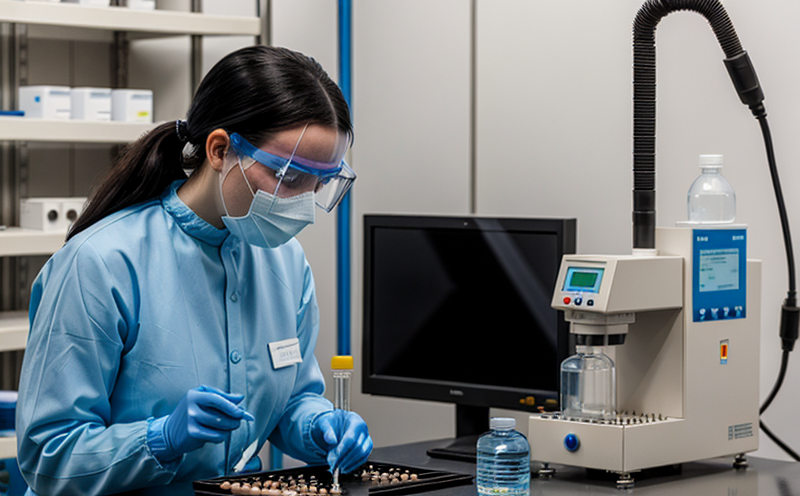Sulfate Residue Profiling Testing
In the pharmaceutical industry, ensuring product quality and safety is paramount. One critical aspect of this is understanding the presence and levels of sulfate residues in drug substances or formulations. Sulfate residue profiling testing provides a comprehensive analysis that helps identify potential impurities, assess compliance with regulatory standards, and ensure consistent batch-to-batch quality.
The process involves several steps to accurately profile sulfate residues. First, an appropriate sample is collected from the drug substance or formulation. This sample undergoes rigorous pretreatment procedures to remove any interfering components that could affect the test results. The sample is then subjected to chromatographic techniques such as High-Performance Liquid Chromatography (HPLC) and Gas Chromatography-Mass Spectrometry (GC-MS), which are highly sensitive methods capable of detecting even trace amounts of sulfate residues.
The chromatographic separation allows for the precise identification and quantification of various compounds, including sulfates. Once separated, these components are analyzed using mass spectrometry to determine their molecular weight and structure, providing a detailed profile of the sulfate residues present. This detailed information is crucial for understanding not only the presence but also the nature of any impurities.
The results from this testing process provide valuable insights into potential sources of contamination or degradation products that may have formed during manufacturing processes or storage conditions. Regulatory bodies, such as the US FDA and EU EMA, mandate strict controls over sulfate residues due to their potential impact on drug efficacy and patient safety. Compliance with these standards is essential for maintaining market access and ensuring product quality.
Our laboratory employs state-of-the-art equipment and methodologies to conduct this testing efficiently and accurately. Our team of experts ensures that every step from sample preparation to final analysis meets the highest quality standards, providing reliable data that can be used to make informed decisions about process improvements or formulation adjustments.
In summary, sulfate residue profiling testing is a vital tool in pharmaceutical development and manufacturing. It allows for precise identification and quantification of sulfate residues, ensuring compliance with regulatory requirements while enhancing product safety and efficacy. By leveraging advanced analytical techniques, we offer clients comprehensive support to meet these challenging demands effectively.
Why It Matters
The importance of sulfate residue profiling testing in pharmaceuticals cannot be overstated. Sulfates can arise from various sources throughout the drug development and manufacturing processes, potentially leading to impurities that may affect product stability, efficacy, or even safety.
One significant source of sulfates is raw materials used during synthesis or purification steps. If not properly controlled, these residues could contaminate final products, posing risks for patients. Another critical aspect involves intermediates and solvents employed in production processes, which might leave behind trace amounts of sulfate compounds.
Compliance with international standards such as USP (United States Pharmacopeia) and ICH Q3D (International Conference on Harmonisation) is essential to ensure that pharmaceutical products meet the highest quality expectations. These guidelines emphasize the need for thorough control over sulfate levels in drug substances, emphasizing their impact on product stability.
Moreover, understanding sulfate residues helps in optimizing manufacturing processes by identifying potential areas where improvements can be made. For instance, adjusting reaction conditions or selecting alternative reagents could reduce unwanted side reactions leading to sulfate formation. Additionally, better storage practices and packaging materials might mitigate exposure to environmental factors that promote degradation pathways resulting in increased sulfate content.
The ability to accurately profile sulfate residues also supports ongoing quality assurance efforts through regular monitoring of production batches. By tracking trends over time, manufacturers can detect early signs of inconsistencies or deviations from desired specifications, allowing for timely corrective actions if necessary. This proactive approach fosters continuous improvement within operations while maintaining stringent adherence to regulatory expectations.
Benefits
Sulfate residue profiling testing offers numerous advantages that contribute significantly to pharmaceutical product development and manufacturing processes:
Enhanced Quality Control: By accurately identifying and quantifying sulfate residues, manufacturers can ensure consistent quality across all batches. This reduces the risk of batch-to-batch variability, which is crucial for maintaining uniformity in therapeutic efficacy.
Regulatory Compliance: Meeting stringent regulatory requirements not only ensures legal compliance but also enhances market credibility and trust among consumers. Adherence to standards like USP and ICH Q3D demonstrates a commitment to excellence that can positively influence brand perception.
Patient Safety: Ensuring low levels of sulfate residues minimizes the risk of adverse effects on patients, thereby upholding high standards of healthcare delivery.
Process Optimization: Identifying sources of sulfate contamination allows manufacturers to refine their processes, leading to more efficient and effective operations. This can result in cost savings by reducing waste and increasing productivity.
Improved Product Stability: Understanding how sulfate residues interact with other components within a formulation helps formulate stable products that maintain desired properties over extended periods.
Industry Applications
Sulfate residue profiling testing finds application across various segments of the pharmaceutical industry. Here are some key areas where this service is particularly relevant:
New Drug Substance Development: During early-stage research, identifying potential sulfate residues aids in selecting optimal raw materials and optimizing synthesis routes to minimize unwanted byproducts.
Manufacturing Process Optimization: By profiling sulfate residues at different stages of production, manufacturers can pinpoint specific steps where improvements are needed. This includes refining purification methods or adjusting reaction conditions to reduce sulfate formation.
Formulation Design: Understanding the role of sulfate residues in formulations helps tailor excipients and solvents more effectively. It ensures that these components do not introduce unwanted impurities into final products.
Bioequivalence Studies: Ensuring minimal sulfate residue levels supports bioavailability studies by preventing interference with active pharmaceutical ingredients (APIs).
Stability Testing: Regular monitoring of sulfate residues during storage and shelf-life testing provides critical data on product stability over time. This information is vital for predicting long-term performance.
Quality Assurance Audits: Compliance with regulatory expectations requires regular internal audits, where sulfate residue profiling plays a key role in validating batch records and ensuring adherence to quality standards.





